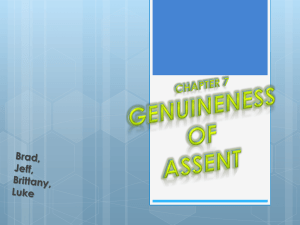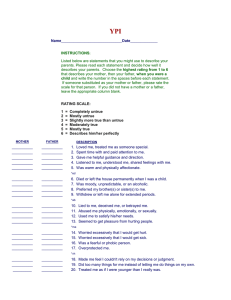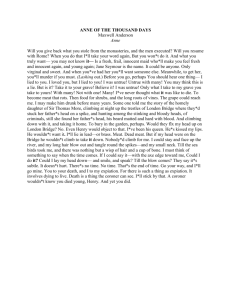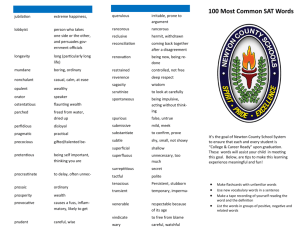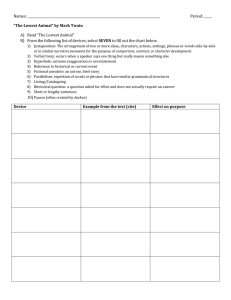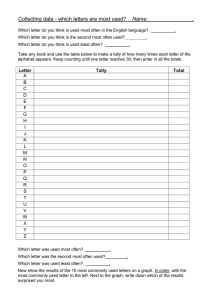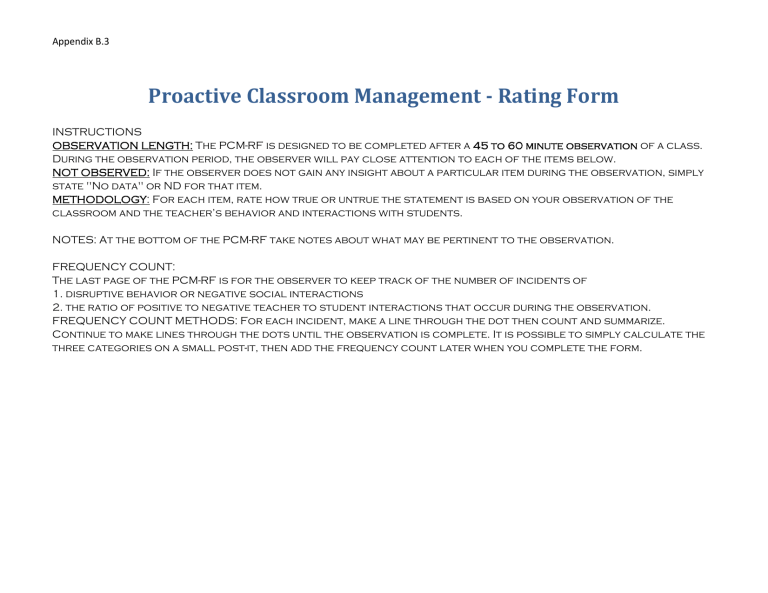
Appendix B.3 Proactive Classroom Management ‐ Rating Form INSTRUCTIONS OBSERVATION LENGTH: The PCM-RF is designed to be completed after a 45 to 60 minute observation of a class. During the observation period, the observer will pay close attention to each of the items below. NOT OBSERVED: If the observer does not gain any insight about a particular item during the observation, simply state "No data" or ND for that item. METHODOLOGY: For each item, rate how true or untrue the statement is based on your observation of the classroom and the teacher’s behavior and interactions with students. NOTES: At the bottom of the PCM-RF take notes about what may be pertinent to the observation. FREQUENCY COUNT: The last page of the PCM-RF is for the observer to keep track of the number of incidents of 1. disruptive behavior or negative social interactions 2. the ratio of positive to negative teacher to student interactions that occur during the observation. FREQUENCY COUNT METHODS: For each incident, make a line through the dot then count and summarize. Continue to make lines through the dots until the observation is complete. It is possible to simply calculate the three categories on a small post-it, then add the frequency count later when you complete the form. Appendix B.3 Subject:___________________________________ Beginning Time:___________________________ ITEMS SPACE The classroom is arranged to allow for non-disruptive, easy flow of traffic (e.g., student going to the restroom, teacher helping individual students). The teacher has clearly distinguished his/her space from the student’s space. SEATING ARRANGEMENT Date:________________________ Ending Time:_________________________ 1 (Very Untrue) 2 (Untrue) 3 (Unsure) 4 (True) 5 (Very True) 1 (Very Untrue) 2 (Untrue) 3 (Unsure) 4 (True) 5 (Very True) 1 (Very Untrue) 2 (Untrue) 3 (Unsure) 4 (True) 5 (Very True) Students with problem behaviors appear to be seated next to one another or facing each other The seats are arranged so there are very few sources of distraction (e.g., seats facing away from window, minimal outside noise, walls organized). Seating arrangement allows teacher to move about the room freely and maintain adequate supervision of students at all times. Students are seated such that they have to engage in as minimal effort as possible to pay attention to the lecture (no strain) POSITIVE CLIMATE The teacher delivers a higher rate of positive statements than corrective statements or reprimands. (It is helpful to Tally Positives and Negatives on last page then decide on score for this item) Teacher has a positive affect when interacting with students Students appear to interact positively with one another. Appendix B.3 TEACHER BEHAVIORS Teacher scans the room to catch/praise students meeting behavior expectations. Teacher is mobile, interacts with students to maintain engagement both during instruction and when monitoring independent or small group work.. Teacher maintains a positive affect by smiling and being nice to students Teacher does not rely on "lecture, then complete worksheets" as a primary strategy. Teacher is mobile and maintains proximity to problem behavior students. Teacher provides many opportunities for students to respond, answer questions, and participate. BEHAVIORAL EXPECTATIONS Classroom expectations/rules are clearly posted so students can see them at all times. Number of rules posted____________ Teacher rewards or praises students for exhibiting behavioral expectations Teacher has observable systems (charts, point cards, etc.) that reward for success rather than focusing on removal of privileges or punishes (e.g., name on board, pulling cards) REACTIVE STRATEGIES Teacher responds to inappropriate behavior by prompting the student to use appropriate behavior Teacher responds to inappropriate behavior with reprimand, disapproval statement, or removal Teacher ignores inappropriate attempts by students to gain attention 1 (Very Untrue) 2 (Untrue) 3 (Unsure) 4 (True) 5 (Very True) 1 (Very Untrue) 2 (Untrue) 3 (Unsure) 4 (True) 5 (Very True) 1 (Very Untrue) 2 (Untrue) 3 (Unsure) 4 (True) 5 (Very True) Appendix B.3 NOTES/Comments: ____________________________________________________________________________________________________________ ____________________________________________________________________________________________________________ ___________________________________________________________________________________________________________ ____________________________________________________________________________________________________________ ___________________________________________________________________________________________________________ 1. Incidents of Disruptive Behavior and/or Negative Social Interactions between students (put a slash through each dot to keep track) Tally total_______ . . . . . . . .. . . . . . . .. . . . . . . . . . . . . . . . . . . . . 2. Tally of Negative Statements/Interactions between Teacher/Student (angry look, reprimand, punisher applied, corrective statement) (put a slash through each dot to keep track) Tally total______ . . . . . . . .. . . . . . . .. . . . . . . .. . . . . . . . . . . . . 3. Tally of Positive Statements/Interactions between Teacher/Student (gestures, verbal praise, etc.) (put a slash through each dot to keep track) Tally total______ . . . . . . . .. . . . . . . .. . . . . . . .. . . . . . . . . . . . .
